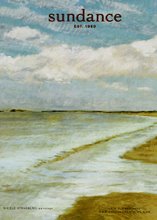The Urban Myth: Visions of the City.
At Sullivan Goss, An American Gallery. Shows through October 7.
Thursday, August 30, 2007
City air makes free” was the slogan of medieval serfs, who could escape their enslavement to the great rural landowners by migrating to the city, where such customary obligations did not apply. Out of this early modern political anomaly has risen what this group show terms “the urban myth,” a complex and ever-evolving set of ideas and assumptions about what city life has to offer. The exhibition is organized into three sections in order to show the urban myth in historical process.The first room is devoted to romantic ideas of the city, and contains both the show’s oldest image: a marvelous Fernand Lundgren gouache from 1888 depicting elegantly attired ladies and gentleman promenading through a gas-lit Central Park; and one of its most self-consciously modern ones: Julius Shulman’s iconic 1960 photograph of Case Study House #22.
The second section, labeled Gritty Cities, brings the analytic and descriptive tools of realism and precisionism to bear on the urban landscape. Although the work included once again spans a long stretch of time, the dominant note in this room is one of isolation. Even the riders on the subway in David P. Cooke’s “Downtown Gig,” who have the instruments and the talent to communicate, appear to be each lost in his or her own thoughts. Peter Ruta and Nicole Strasburg both contribute stirring visions of the so-called border vacuums that grow up where the city meets its limits, whether these be natural, as is the case with the waterfront, or artificial, as with the empty concrete foreground of Strasburg’s monumental new painting, “New York” (2007).
The final room is termed Deconstructed Cities. Often fragmentary or otherwise interrupted, these pictures and objects attempt to conjure a vision of the urban present and future. Barry Berkus contributes some spectacular drawings for New Urban Forms, and underlines them with a model/sketch made from a single sheet of crumpled paper. Wayne McCall’s “Bifurcation” (2007) captures the unlikely appearance of a wrecked automobile stood on its end and bursting through one of the interior walls of an otherwise average-looking apartment. It’s a great and haunting image — sort of John Chamberlain meets William Eggleston. The entire show is of genuine interest, particularly now as Santa Barbara faces the reality that, like it or not, the urban myth includes us.










No comments:
Post a Comment